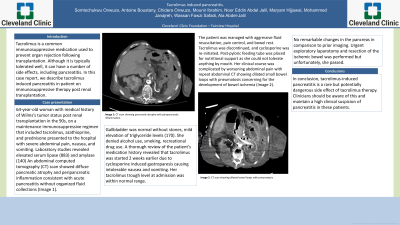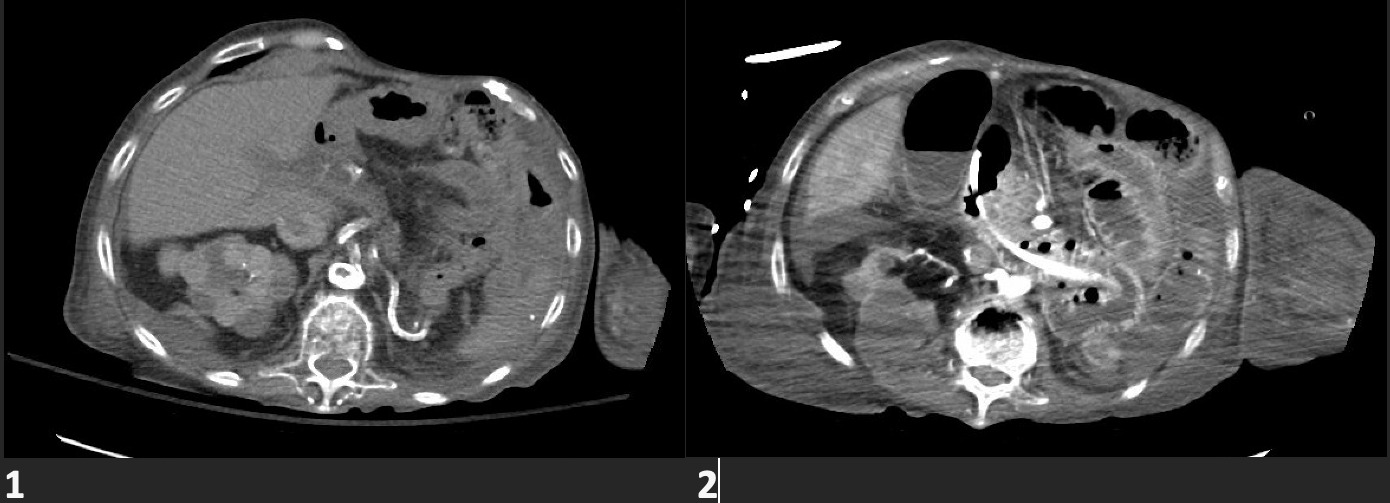Monday Poster Session
Category: Biliary/Pancreas
P1484 - An Interesting Case of Tacrolimus-Induced Pancreatitis
Monday, October 23, 2023
10:30 AM - 4:15 PM PT
Location: Exhibit Hall

Has Audio

Mounir Ibrahim, MD
Cleveland Clinic Foundation
Cleveland, OH
Presenting Author(s)
Somtochukwu Onwuzo, MD1, Antoine Boustany, MD2, Chidera Onwuzo, MBBS3, Mounir Ibrahim, MD2, Noor Eddin Abdel Jalil, MD4, Maryam Hijjawai, MD4, Mohammed Janajreh, MD5, Wassan Fawzi. Safadi, MD4, Ala Abdel-Jalil, MD2
1Cleveland Clinic Foundation, Fairview Park, OH; 2Cleveland Clinic Foundation, Cleveland, OH; 3General Hospital Lagos, Fairview Park, OH; 4University of Jordan, Cleveland, OH; 5Al-Najah University, Cleveland, OH
Introduction: TTacrolimus is a common immunosuppressive medication used to prevent organ rejection following transplantation. Although it is typically tolerated well, it can have several side effects, and uncommonly pancreatitis. In this case report, we describe tacrolimus-induced pancreatitis in a patient on immunosuppressive therapy post renal transplantation.
Case Description/Methods: A 64-year-old woman with a medical history of Wilms’s tumor status post remote renal transplantation, on a maintenance immunosuppressive regimen that included tacrolimus, azathioprine, and prednisone, presented to the hospital with severe abdominal pain, nausea, and vomiting. Laboratory studies revealed elevated serum lipase (883 U/L) and amylase (140 U/L). An abdominal computed tomography (CT) scan showed diffuse pancreatic atrophy and peripancreatic inflammation consistent with acute interstitial pancreatitis without fluid collections (Image 1). Gallbladder was normal without stones, with mild elevation of triglyceride levels (170 mg/dl). She denied alcohol use, smoking, and recreational drug use. No family history of pancreatic disease A thorough review of the patient's medication history revealed that tacrolimus was started 2 weeks earlier due to cyclosporine-induced gastroparesis causing intolerable nausea and vomiting. Her tacrolimus trough level at admission was within normal range. A diagnosis of tacrolimus-induced acute pancreatitis was presumed.
The patient was managed with aggressive fluid resuscitation, pain control, and bowel rest. Tacrolimus was discontinued, and cyclosporine was re-initiated. Post-pyloric feeding tube was placed for nutritional support as she could not tolerate anything by mouth. Her clinical course was complicated by worsening abdominal pain with repeat abdominal CT showing dilated small bowel loops with pneumatosis concerning for bowel ischemia (Image 2). No remarkable changes in the pancreas in comparison to prior imaging. Urgent exploratory laparotomy and resection of the ischemic bowel was performed, but unfortunately, she passed away
Discussion: Tacrolimus-induced pancreatitis is a rare but potentially serious side effect of tacrolimus therapy. Clinicians should be aware of this and maintain a high clinical suspicion of pancreatitis in these patients should they develop clinical signs suggestive of pancreatic disease shortly after its commencement.

Disclosures:
Somtochukwu Onwuzo, MD1, Antoine Boustany, MD2, Chidera Onwuzo, MBBS3, Mounir Ibrahim, MD2, Noor Eddin Abdel Jalil, MD4, Maryam Hijjawai, MD4, Mohammed Janajreh, MD5, Wassan Fawzi. Safadi, MD4, Ala Abdel-Jalil, MD2. P1484 - An Interesting Case of Tacrolimus-Induced Pancreatitis, ACG 2023 Annual Scientific Meeting Abstracts. Vancouver, BC, Canada: American College of Gastroenterology.
1Cleveland Clinic Foundation, Fairview Park, OH; 2Cleveland Clinic Foundation, Cleveland, OH; 3General Hospital Lagos, Fairview Park, OH; 4University of Jordan, Cleveland, OH; 5Al-Najah University, Cleveland, OH
Introduction: TTacrolimus is a common immunosuppressive medication used to prevent organ rejection following transplantation. Although it is typically tolerated well, it can have several side effects, and uncommonly pancreatitis. In this case report, we describe tacrolimus-induced pancreatitis in a patient on immunosuppressive therapy post renal transplantation.
Case Description/Methods: A 64-year-old woman with a medical history of Wilms’s tumor status post remote renal transplantation, on a maintenance immunosuppressive regimen that included tacrolimus, azathioprine, and prednisone, presented to the hospital with severe abdominal pain, nausea, and vomiting. Laboratory studies revealed elevated serum lipase (883 U/L) and amylase (140 U/L). An abdominal computed tomography (CT) scan showed diffuse pancreatic atrophy and peripancreatic inflammation consistent with acute interstitial pancreatitis without fluid collections (Image 1). Gallbladder was normal without stones, with mild elevation of triglyceride levels (170 mg/dl). She denied alcohol use, smoking, and recreational drug use. No family history of pancreatic disease A thorough review of the patient's medication history revealed that tacrolimus was started 2 weeks earlier due to cyclosporine-induced gastroparesis causing intolerable nausea and vomiting. Her tacrolimus trough level at admission was within normal range. A diagnosis of tacrolimus-induced acute pancreatitis was presumed.
The patient was managed with aggressive fluid resuscitation, pain control, and bowel rest. Tacrolimus was discontinued, and cyclosporine was re-initiated. Post-pyloric feeding tube was placed for nutritional support as she could not tolerate anything by mouth. Her clinical course was complicated by worsening abdominal pain with repeat abdominal CT showing dilated small bowel loops with pneumatosis concerning for bowel ischemia (Image 2). No remarkable changes in the pancreas in comparison to prior imaging. Urgent exploratory laparotomy and resection of the ischemic bowel was performed, but unfortunately, she passed away
Discussion: Tacrolimus-induced pancreatitis is a rare but potentially serious side effect of tacrolimus therapy. Clinicians should be aware of this and maintain a high clinical suspicion of pancreatitis in these patients should they develop clinical signs suggestive of pancreatic disease shortly after its commencement.

Figure: CT scan showing pancreatic atrophy with peripancreatic inflammation and dilated bowel loops with pneumatosis respectively
Disclosures:
Somtochukwu Onwuzo indicated no relevant financial relationships.
Antoine Boustany indicated no relevant financial relationships.
Chidera Onwuzo indicated no relevant financial relationships.
Mounir Ibrahim indicated no relevant financial relationships.
Noor Eddin Abdel Jalil indicated no relevant financial relationships.
Maryam Hijjawai indicated no relevant financial relationships.
Mohammed Janajreh indicated no relevant financial relationships.
Wassan Safadi indicated no relevant financial relationships.
Ala Abdel-Jalil indicated no relevant financial relationships.
Somtochukwu Onwuzo, MD1, Antoine Boustany, MD2, Chidera Onwuzo, MBBS3, Mounir Ibrahim, MD2, Noor Eddin Abdel Jalil, MD4, Maryam Hijjawai, MD4, Mohammed Janajreh, MD5, Wassan Fawzi. Safadi, MD4, Ala Abdel-Jalil, MD2. P1484 - An Interesting Case of Tacrolimus-Induced Pancreatitis, ACG 2023 Annual Scientific Meeting Abstracts. Vancouver, BC, Canada: American College of Gastroenterology.
